Romare Bearden and Abstraction
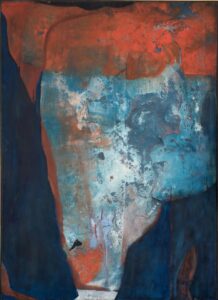
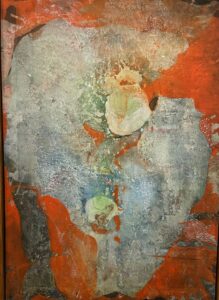
In “Romare Bearden Abstraction” the artist surprises us in every work. He constantly explores new media, color, and content. Here we see two paintings from 1959, Strange Land on the left and the Silent Valley of Sunrise on the right. Both suggest the shape of Africa, although according to the label it can be shown with either way up because the artist signed it on both ends. They are perfect examples of what I am exploring here, cloaked references.
These abstract paintings seem entirely different from his famous collage works such as Melon Season, 1967 or La Primavera 1967 , the two works here.
Or are they? Let’s look more closely. Notice the face in Melon Season is composed of many faces, you can identify at least five, suggesting many layers of identity that is a pointed variation on Picasso’s technique with split faces Her striped dress with strong parallel lines is the same pattern used in an earlier abstract painting
Untitled, Multicolored Stripes 1959
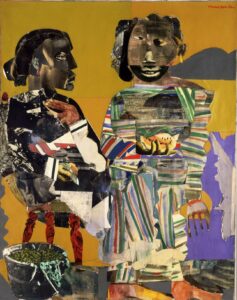
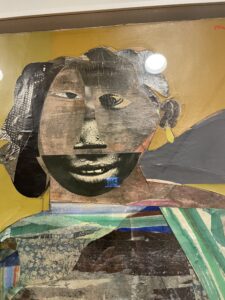
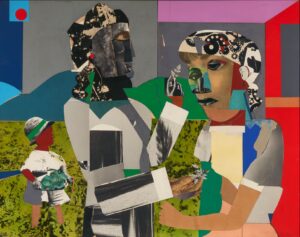
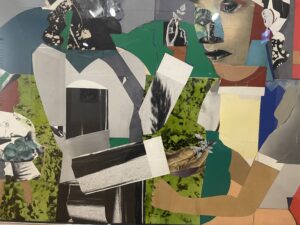 Look at the black and white patterns in La Primavera!
Look at the black and white patterns in La Primavera!
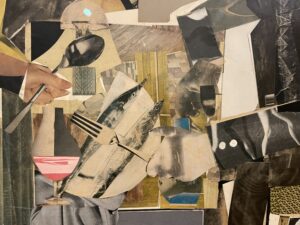 Here is a detail of Fish Fry, 1967 that clearly reveals the interplay of real objects, spoon and fork, with a complex built up pattern.
Here is a detail of Fish Fry, 1967 that clearly reveals the interplay of real objects, spoon and fork, with a complex built up pattern.
Romare Bearden began to add racially focused collaged figures to his abstract work starting in 1964 at the height of the Civil Rights, following participation in the Spiral Group. Bearden founded Spiral in his studio after the 1963 March on Washington with artists, writers and poets, in order to discuss the role of representation of the African American experience in art at a time that abstraction dominated mainstream art. As a result he turned to figurative collage.
But looking at the abstractions and the figurative works in the current show we see that he was only rarely a fully abstract artist. Here are two examples that show his technical explorations.
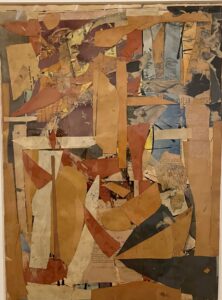
Untitled, ca. 1956 Mixed media, newspaper and magazine clippings over watercolor and ink on paper [recto]
Looking closely I see not figures, but definitely content that connects to Bearden’s identity as an African American artist. The shades of browns, the layering from dark to light in the 1956 work is striking. As in African American’s specific and detailed description of skin color, ( look at Walter Moseley’s wonderful characters) here we have about ten shades of brown and tan. The artist himself was a very light skinned African American.
I want to explore this idea of certain colors, especially shades of brown as a metaphor of African Americans, by looking at another painting Robert Duncanson’s, Still Life with Fruit and Nuts from 1848
This painting was extensively discussed by the eminent John Wilmerding in the Wall Street Journal as “out of many parts, one painting” but what I see is the prominence of brown raisins in the center of the work, as the dominant motif; the green raisins are set aside. There are also cracked brown nuts, in other words a subtle palette that can contain many metaphors. I use this comparison to support my idea of hidden content in Bearden’s work by his use of specific shades of tan and brown.
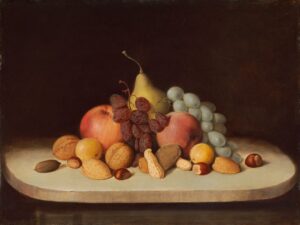
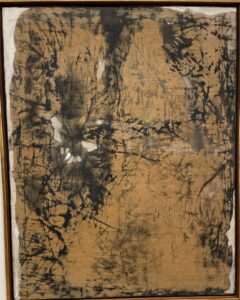
Old Poem, ca. 1960
Oil and ink on linen
In this case, the work looks more like a spider web of lines, again on a tan surface. As we look at it though it does seem like an old page, but also a geologic formation, or an indirect reference to calligraphy released from forming characters. He studied Chinese calligraphy and sumi painting technique in the late 1950s.
His exploration of technique, experiment with pigments, global span of sources, historical studies of old masters, all appear in these abstract works. At the same time, as we look at the figurative works we can see that all of these qualities continue as the foundation for his well known works after 1965.
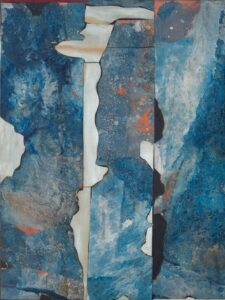
For example in River Mist, 1962 he works with oil on unprimed linen, casein and colored pencil cut torn on painted on board. Key to his aesthetic is his dark brown underpainting . In other words he layers and layers going from dark to light, from one medium to another. Lurking in this particular work are silhouettes that can evoke rising mists, architectural elements, facial profiles, archeological formations, or celestial events.
That fluid movement between different ways of seeing appears in most of these abstractions.
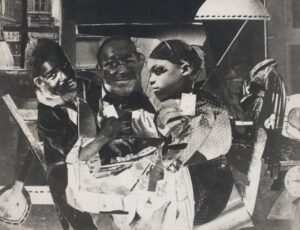
Then we have the change in 1964 in a work like 9:10, 461 Lenox Avenue of a gelatin silver print (photostat) on fiberboard or its small partner and source of the same title, made with layered collage, that suddenly gives us faces. To me it evokes Cezanne’s cardplayers, three people sitting around a table playing cards. But they are embedded in a complex abstraction of shades of brown, and white that make the faces pop out. Two men and a woman.
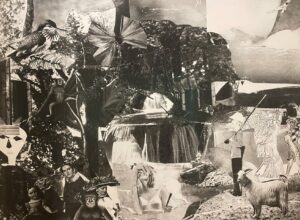
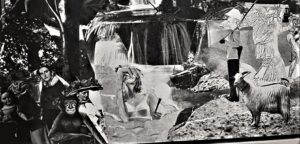
As Bearden worked with collage imagery in complex layers ( this is Explusion from Paradise, 1964, a very odd image, a monkey lower left, a reclining blond center, a colonial soldier and a goat right), the figure ground relationship, the scale of the figures, the utilization of abstract form, constantly shifts. As we look at these works through our exposure to his abstracted experiment work of the late 1950s and early 1960s, we see both the subjects, and the abstraction.
Sometimes an entire landscape takes over and the figure is embedded in it. In another example, the landscape is composed of figures, bound together by a subtly low key palette of yellow and greens. Looking at the subdued close valued browns, blues, mauves, yellows and reds of his abstract painting I feel they have an affinity to his African American identity, in some cases he uses at least ten shades of brown!
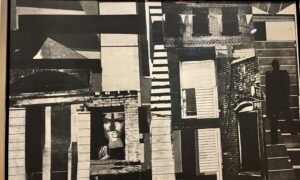
Even black and white suggests so many tonalities, here in Spring Way, 1964
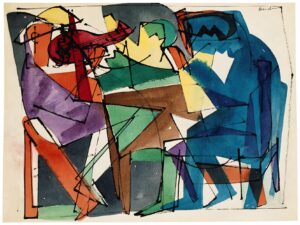
I want to end though where he began, because the earliest works such as The Blues Has Got Me, 1944 immediately reveal his sophisticated transformations of established styles such as cubism and expressionism. This is before he went to Paris in 1950! The work incorporates music as a direct reference (he composed music after he returned from Paris). an aspect of Bearden that certainly refers again to the abstract.
Ralph Ellison said it best as quoted in the book, Memory and Metaphor, The Art of Romare Bearden, 1940-1987 ( Studio Museum, 1991) Ellison declared that Bearden conveyed the “sharp breaks, leaps in consciousness, distortions, paradoxes, reversals, telescoping of time and Surreal blending of styles, values, hopes and dreams which characterize much of Negro American history”
This entry was posted on September 21, 2022 and is filed under Uncategorized.








